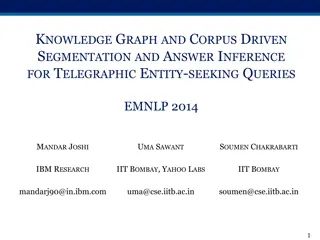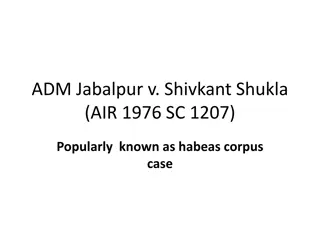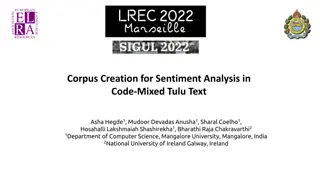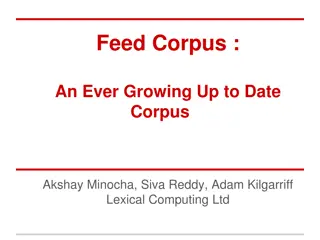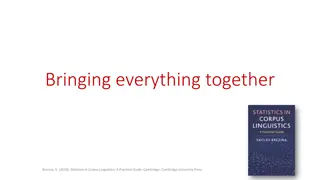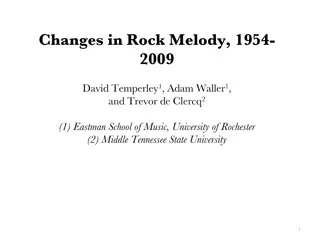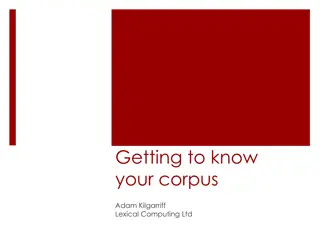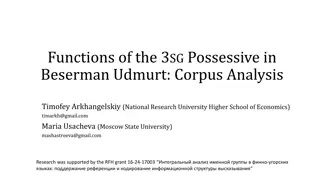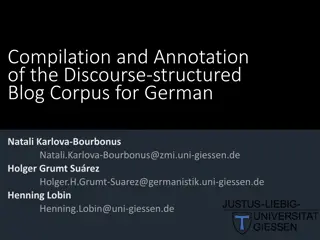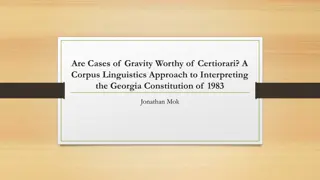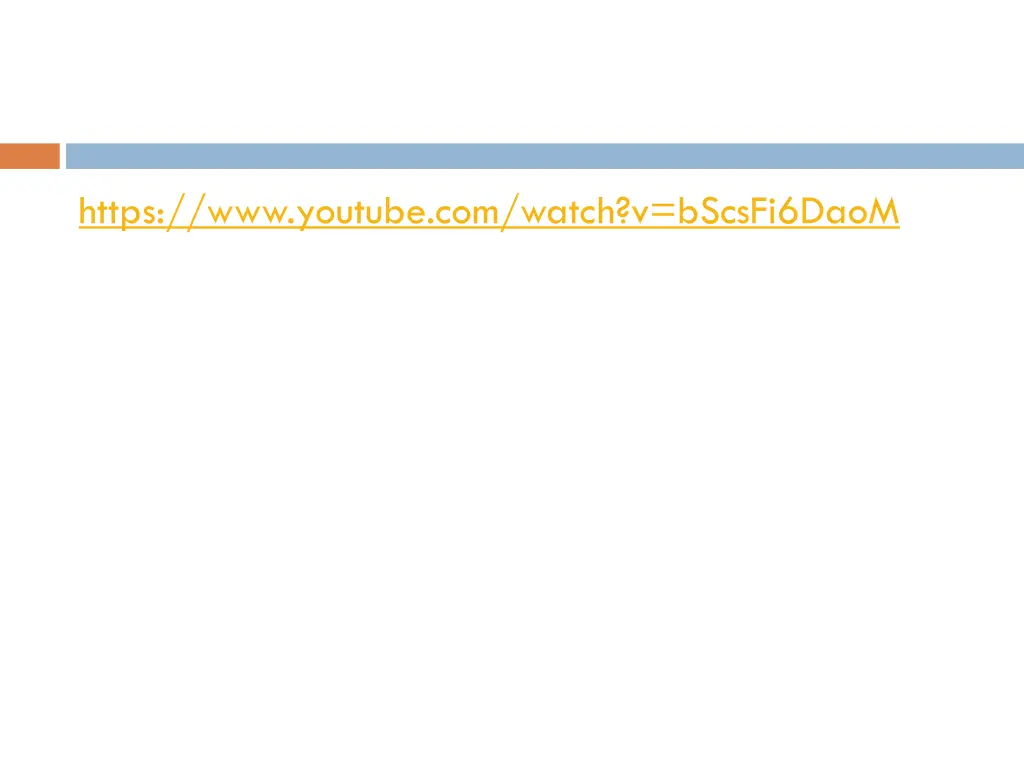
Understanding Corpus Analysis in NLP: Models, Characteristics, and Examples
Explore the world of corpus analysis in Natural Language Processing (NLP) through models, defining characteristics, and real-world examples like linguistic resources and monolingual text data sets. Gain insights into how language is learned and the debate between Rationalist and Empiricist perspectives. Dive into the fundamentals of corpora, including vocabulary, sentences, documents, and the sources and sizes of different corpus types. Discover various corpus examples from Twitter, chatrooms, to parallel data sets with multiple languages, offering a rich learning experience in NLP.
Download Presentation

Please find below an Image/Link to download the presentation.
The content on the website is provided AS IS for your information and personal use only. It may not be sold, licensed, or shared on other websites without obtaining consent from the author. If you encounter any issues during the download, it is possible that the publisher has removed the file from their server.
You are allowed to download the files provided on this website for personal or commercial use, subject to the condition that they are used lawfully. All files are the property of their respective owners.
The content on the website is provided AS IS for your information and personal use only. It may not be sold, licensed, or shared on other websites without obtaining consent from the author.
E N D
Presentation Transcript
CORPUS ANALYSIS David Kauchak NLP Spring 2019
Administrivia Assignment 0 Assignment 1 out due Monday at 11am (don t wait until the weekend!) no code submitted, but will require coding will require some command-line work Reading
NLP models How do people learn/acquire language?
NLP models A lot of debate about how human s learn language Rationalist (e.g. Chomsky) Empiricist From my perspective (and many people who study NLP) I don t care :) Strong AI vs. weak AI: don t need to accomplish the task the same way people do, just the same task Machine learning Statistical NLP
Vocabulary Word a unit of language that native speakers can identify words are the blocks from which sentences are made Sentence a string of words satisfying the grammatical rules of a language Document A collection of sentences Corpus A collection of related texts
Corpus examples Any you ve seen or played with before?
Corpus characteristics What are some defining characteristics of corpora?
Corpus characteristics monolingual vs. parallel language annotated (e.g. parts of speech, classifications, etc.) source (where it came from) size
Corpus examples Linguistic Data Consortium http://www.ldc.upenn.edu/Catalog/byType.jsp Dictionaries WordNet 206K English words CELEX2 365K German words Monolingual text Gigaword corpus 4M documents (mostly news articles) 1.7 trillion words 11GB of data (4GB compressed) Enron e-mails 517K e-mails
Corpus examples Monolingual text continued Twitter Chatroom Many non-English resources Parallel data ~10M sentences of Chinese-English and Arabic-English Europarl ~25M sentence pairs with English with 21 different languages 260K sentences of English Wikipedia Simple English Wikipedia
Corpus examples Annotated Brown Corpus 1M words with part of speech tag Penn Treebank 1M words with full parse trees annotated Other treebanks Treebank refers to a corpus annotated with trees (usually syntactic) Chinese: 51K sentences Arabic: 145K words many other languages BLIPP: 300M words (automatically annotated)
Corpora examples Many others Spam and other text classification Google n-grams 2006 (24GB compressed!) 13M unigrams 300M bigrams ~1B 3,4 and 5-grams Speech Video (with transcripts)
Corpus analysis Corpora are important resources Often give examples of an NLP task we d like to accomplish Much of NLP is data-driven! A common and important first step to tackling many problems is analyzing the data you ll be processing
Corpus analysis What types of questions might we want to ask? How many documents, sentences, words On average, how long are the: documents, sentences, words What are the most frequent words? pairs of words? How many different words are used? Data set specifics, e.g. proportion of different classes?
Corpora issues Somebody gives you a file and says there s text in it Issues with obtaining the text? text encoding language recognition formatting (e.g. web, xml, ) misc. information to be removed header information tables, figures footnotes
A rose by any other name Word a unit of language that native speakers can identify words are the blocks from which sentences are made Concretely: We have a stream of characters We need to break into words What is a word? Issues/problem cases? Word segmentation/tokenization?
Tokenization issues: Finland s capital ?
Tokenization issues: Finland s capital Finland s Finland Finland s Finlands Finland s Finland s What are the benefits/drawbacks?
Tokenization issues: Aren t we ?
Tokenization issues: Aren t we Arent Aren t Are n t Aren t Are not
Tokenization issues: hyphens Hewlett-Packard state-of-the-art lower-case co-education take-it-or-leave-it 26-year-old ?
Tokenization issues: hyphens Hewlett-Packard state-of-the-art co-education lower-case Keep as is merge together HewlettPackard What are the benefits/drawbacks? stateoftheart Split on hyphen lower case co education
More tokenization issues Compound nouns: San Francisco, Los Angelos, One token or two? Numbers Examples Dates: 3/12/91 Model numbers: B-52 Domain specific numbers: PGP key - 324a3df234cb23e Phone numbers: (800) 234-2333 Scientific notation: 1.456 e-10
Tokenization: language issues Lebensversicherungsgesellschaftsangestellter life insurance company employee Opposite problem we saw with English (San Francisco) German compound nouns are not segmented German retrieval systems frequently use a compound splitter module
Tokenization: language issues Where are the words? thisissue Many character based languages (e.g. Chinese) have no spaces between words A word can be made up of one or more characters There is ambiguity about the tokenization, i.e. more than one way to break the characters into words Word segmentation problem can also come up in speech recognition
Word counts: Tom Sawyer How many words? 71,370 total 8,018 unique Is this a lot or a little? How might we find this out? Random sample of news articles: 11K unique words What does this say about Tom Sawyer? Simpler vocabulary (colloquial, audience target, etc.)
Word counts Word the and a to of was it in that he I his you Tom with Frequency 3332 2972 1775 1725 1440 1161 1027 906 877 877 783 772 686 679 642 What are the most frequent words? What types of words are most frequent?
Word counts Word Frequency 1 2 3 4 5 6 7 8 9 10 11-50 51-100 > 100 Frequency of frequency 3993 1292 664 410 243 199 172 131 82 91 540 99 102 8K words in vocab 71K total occurrences how many occur once? twice?
ZipfsLaw The frequency of the occurrence of a word is inversely proportional to its frequency of occurrence ranking Their relationship is log-linear, i.e. when both are plotted on a log scale, the graph is a straight line George Kingsley Zipf 1902-1950
Zipfs law At a high level: a few words occur veryfrequently a medium number of elements have medium frequency many words occur very infrequently
Zipfs law f =C 1 r The product of the frequency of words (f) and their rank (r) is approximately constant Constant is corpus dependent, but generally grows roughly linearly with the amount of data
Zipf Distribution Illustration by Jacob Nielsen
Zipfs law: Brown corpus log log
Zipfs law: Tom Sawyer Word Frequency Rank the and 3332 ? 1 2 f =C 1 r C= f *r =3332 f =3332 *1 2 =1666
Zipfs law: Tom Sawyer Word Frequency Rank the and 3332 2972 1 2 f =C 1 r C= f *r =3332 f =3332 *1 2 =1666
Zipfs law: Tom Sawyer Word Frequency Rank the and a ***** 2972 ? f =C 1 1 2 3 r C= f *r =2972*2 f =5944 *1 3 =1981 =5944
Zipfs law: Tom Sawyer Word Frequency Rank the and a ***** 2972 1775 f =C 1 1 2 3 r C= f *r =2972*2 f =5944 *1 3 =1981 =5944
Zipfs law: Tom Sawyer Word Frequency Rank he friends 877 ? 10 800 f =C 1 r C= f *r =877*10 f =8770 *1 800 =10.96 =8770
Zipfs law: Tom Sawyer Word Frequency Rank he friends 877 10 10 800 f =C 1 r C= f *r =877*10 f =8770 *1 800 =10.96 =8770
Zipfs law: Tom Sawyer Word Frequency Rank C = f * r the and a he but be Oh two name group friends family sins Applausive 3332 2972 1775 877 410 294 116 104 21 13 10 8 2 1 1 2 3 10 20 30 90 100 400 600 800 1000 3000 8000 3332 5944 5235 8770 8400 8820 10440 10400 8400 7800 8000 8000 6000 8000 What does this imply about C/zipf s law? How would you pick C?
Sentences Sentence a string of words satisfying the grammatical rules of a language Sentence segmentation How do we identify a sentence? Issues/problem cases? Approach?
Sentence segmentation: issues A first answer: something ending in a: . ? ! gets 90% accuracy Dr. Dave gives us just the right amount of homework. Abbreviations can cause problems
Sentence segmentation: issues A first answer: something ending in a: . ? ! gets 90% accuracy The scene is written with a combination of unbridled passion and sure-handed control: In the exchanges of the three characters and the rise and fall of emotions, Mr. Weller has captured the heartbreaking inexorability of separation. sometimes: : ; and might also denote a sentence split
Sentence segmentation: issues A first answer: something ending in a: . ? ! gets 90% accuracy You remind me, she remarked, of your mother. Quotes often appear outside the ending marks
Sentence segmentation Place initial boundaries after: . ? ! Move the boundaries after the quotation marks, if they follow a break Remove a boundary following a period if: it is a known abbreviation that doesn t tend to occur at the end of a sentence (Prof., vs.) it is preceded by a known abbreviation and not followed by an uppercase word
Sentence length What is the average sentence length, say for news text? 23 Length 1-5 6-10 11-15 16-20 21-25 26-30 31-35 36-40 41-45 46-50 51-100 101+ percent 3 8 14 17 17 15 11 7 4 2 1 0.01 cumul. percent 3 11 25 42 59 74 86 92 96 98 99.99 100

